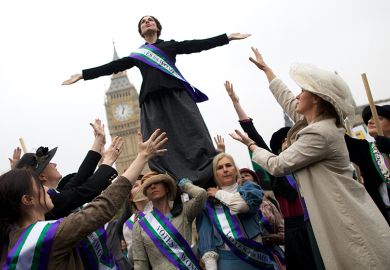Stage performers played a key role in the feminist movement, writes June Purvis.
This fascinating book explores a neglected theme, namely the contribution made by female performers in American popular theatre from the 1880s to the 1920s to our modern conceptions of womanhood. Drawing on a wide range of sources, Susan Glenn shows how women employed on the stage challenged conventional notions about female modesty, thus making a critical contribution to the emergence of first-wave feminism.
At the heart of Glenn's analysis lies the magnetic and persuasive French actress Sarah Bernhardt, the epitome of the New Woman. The American press was mesmerised by her when she first visited New York City in November 1880. Bridging the gap between Victorian conventions and modern attitudes, she defied all attempts to categorise her. Although she was a great romantic tragedienne, playing to full effect tearful dying women, she also regularly transgressed traditional gender roles, taking parts intended for men, such as Hamlet. That she frequently cross-dressed when off stage added to her allure. Defiantly defending her right to play male roles by denouncing well-defined stereotypes of masculinity and femininity, Bernhardt became an icon among the homosexual communities in America and Europe.
Gender barriers in stage comedy were broken by a number of comic actresses performing in musical comedies and vaudeville, such as May Irwin, a performer closely associated with what Glenn terms "the coon song idiom". Some of these white performers, such as the world-renowned Sophie Tucker, wore blackface and neck make-up. Even when Tucker later abandoned her racial props and reinvented herself as a "red hot mama", she still sang with a "blackvoice", using the black Southern accent that she had cultivated. Some women mimics, including Cissie Loftus and Elsie Janis, imitated their sister performers. Bernhardt and Ethel Barrymore regularly attended such shows to see how they were represented. The vaudeville mimics, asserts Glenn, became like "artist-intellectuals" who both participated in and critically assessed the cultural practices of the day.
Female mimics in turn-of-the-century America had soon to compete with another craze that swept the country. "The country is Salome mad," lamented one reporter in 1908. Ten years previously, Oscar Wilde's scandalous play, Salome , loosely based on the biblical story, had been banned in England. It told the story of the vengeance of a lustful but thwarted princess who is eventually persuaded to dance for her stepfather, King Herod, when he promises to give her anything she desires. Salome asks for the head of John the Baptist who has turned down her sexual advances. When the head is brought to her on a silver tray, she kisses and caresses it, much to the horror of Herod, who orders her execution.
The play and variations of it, especially the "Dance of the seven veils", grabbed the popular imagination, because they highlighted a gender crisis that was evident at the time, namely that the New Woman could whirl out of control and become a femme fatale who overturned the established gender order. But the part of Salome gave to actresses a chance to play an assertive, sexually expressive woman, a theme that was to be articulated with some force by feminists in the 20th century.
The links between feminist activism and the theatre became especially strong from 1907 until after the first world war as campaigners in the women's suffrage movement organised eye-catching street parades, pageants and outdoor rallies. The trans-Atlantic links between American feminists Harriot Stanton Blatch and Alice Paul and militants in Britain, such as Emmeline and Christabel Pankhurst, were influential in shaping the form and style of spectacle. As Blatch knew only too well, feminists needed publicity if they were to win their cause and one way to do that was to be dramatic and theatrical.
Actresses were often recruited to "the cause" and took parts in suffrage plays, such as Votes for Women , written by the suffragist Elizabeth Robins. The irrepressible, 66-year-old Bernhardt conducted another of her "farewell to America" tours in 1910. Joan of Arc was a patron saint of the suffragists, and a group calling themselves the Joan of Arc Suffrage League greeted the great star on her arrival in New York. Although Bernhardt seems to have been reluctant on this occasion to be openly supportive of votes for women, by 1913 such inhibitions had vanished: "I believe in the independence of women. I am for the vote," she told one reporter in 1913.
After evidence of such feminist commitment, it is something of a comedown to see the way that Broadway producers then created the dancing chorus girl with her long legs and smiling face. As Glenn observes, the popular theatre that had once provided a forum for assertive self-spectacle by women also permitted producers to make a spectacle of women. The chorus girl became epitomised as a gold digger, ruthlessly seeking out wealthy admirers. Although the rise of the Hollywood film industry in the 1930s heralded a decline in the importance of the theatre as a cultural influence, the chorus girl lingered on in countless films.
This wide-ranging book is a good read and will be particularly enjoyed by those with interests in women's studies, women's history, theatre studies and cultural studies. Informative and funny, it conveys well how early female stars, through their assertive self-spectacle, articulated a number of themes that later became central to feminism, especially individualism, economic independence and sexual expressiveness.
June Purvis is professor of women's and gender history, University of Portsmouth.
Female Spectacle: The Theatrical Roots of Modern Feminism
Author - Susan A. Glenn
ISBN - 0 674 00333 0
Publisher - Harvard University Press
Price - £25.50
Pages - 294
Register to continue
Why register?
- Registration is free and only takes a moment
- Once registered, you can read 3 articles a month
- Sign up for our newsletter
Subscribe
Or subscribe for unlimited access to:
- Unlimited access to news, views, insights & reviews
- Digital editions
- Digital access to THE’s university and college rankings analysis
Already registered or a current subscriber?



